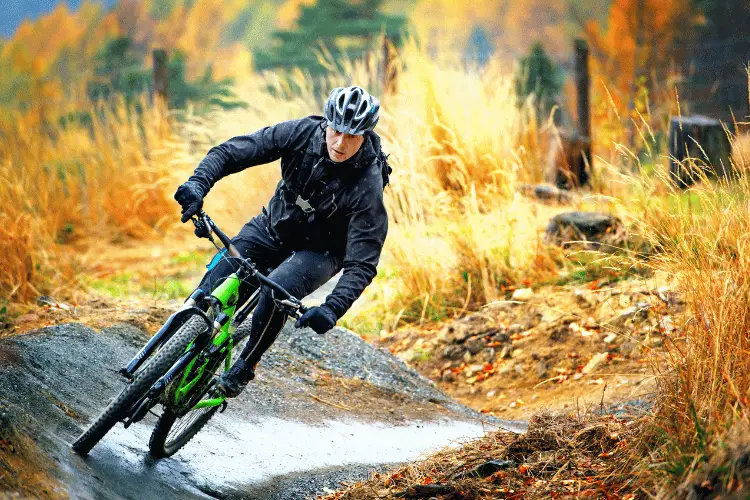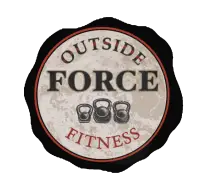Though considered a low-impact sport, mountain biking tones and works various muscles in the body. It targets the lower body extremities—particularly the quads, hamstrings, and calves—and touches on several upper-body muscles like the arms (biceps and triceps), the shoulders (deltoids), and the core (abdominals).
In this article, I’ll discuss the muscles used in mountain biking and their contribution to your power output and balance. I’ll also share some tips on strengthening your upper and lower body muscles for mountain biking.
Let’s get right into it!
What Muscles Are Used In Mountain Biking?
Every sport has its own category of muscle groups responsible for building endurance and muscle. For mountain biking, a sport that heavily utilizes pedaling power, most of the action happens on the lower half of the body—specifically the hips and legs.
When on the bike, the quads and glutes act as the main source of power.
The core and upper body muscles—abdominals, triceps, pectorals, etc.—support and stabilize the upper body to retain your balance while cycling.
The leg, core, and upper body muscles work together to improve your power production and balance on the bike.
No one group is more important than the other. All these muscles play a key role in producing power on the bike.
Leg Muscles
For your lower body, mountain biking works the quads, calves, glutes, and hamstrings.

The quad muscles are the group of muscles located at the front of your thigh. Also known as quadriceps femoris, it comprises four different muscles: rectus femoris, vastus lateralis, vastus intermedius, and the vastus medialis.
These muscles help you deliver a strong downward force on the pedals, pushing you toward the trail. They work in conjunction with the calf muscles, which are activated the moment you hit the pedal with your toes.
On the other hand, the hamstring muscle group consists of the semimembranosus, semitendinosus, and biceps femoris muscles, which are located between the hip and the knee at the back of your leg.
The hamstrings are active in the push-down and pull-up motion of the pedal stroke. They work alongside the calf to lift the leg and assist with flexing the knees up through the back part of the pedal stroke.
They also play a vital role in stabilizing the knee through Bottom Dead Center (BDC or Max Extension), the point at which the leg is fully extended in the pedal stroke.
Glute Muscles
The gluteal muscles comprises of the muscles in the gluteal region (AKA the buttocks): the gluteus minimus, the gluteus medius, and the gluteus maximus.
These muscles initiate the downward phase of the cycling pedal stroke and are therefore activated whenever you’re pedaling. They work together to move your thigh forward and keep you stable.
Core Muscles
Mountain cycling builds your abs and strengthens your core, improving your coordination and balance.
Your rectus abdominis and other core muscles work together to stabilize you while climbing and descending a path.
Biking constantly engages your core to keep yourself balanced on the bike, which, in turn, strengthens the muscles around your trunk.
This is especially true in mountain biking, as uneven terrain forces you to work your core over time to keep you in equilibrium.
Your abdominal muscles are a part of the core’s primary muscle units. A strong core is crucial to a powerful pedal stroke.
Though cycling doesn’t directly build abdominal muscles, it’s an excellent way to burn calories and shed off some fats.
To engage your core while mountain biking, tighten your abs, maintain an upright posture, and keep the weight off your arms.
Upper Body Muscles
Though most of the work comes from the lower limbs, the upper body plays a vital role in stabilizing the spine and maintaining posture.

Mountain biking strengthens the upper body muscles, with a heavy focus on the biceps and triceps and the shoulders (deltoids). Your body activates this muscle group to maintain proper cycling position and stability. The upper muscles help cyclists stand, lean forward, or duck on trail rides without losing balance.
Even the most minimal shifts in body movement add pressure on the upper body. Shifting in and out of the saddle strengthens your triceps and biceps, especially during descents and the presence of vibrational forces. Your forearms aid with braking and gripping the handlebars, while your shoulders help with the stability of your upper body.
Mounting biking also engages the latissimus dorsi muscle on your back, which occupies most of the lower posterior thorax.
The same can be said with the trapezius back muscles and the rhomboid back muscles. They stabilize the contralateral torque, allowing you to control multiple extensor and flexor leg muscles when cycling up or down a mountain.
How to Strengthen Your Upper and Lower Body Muscles For Mountain Biking
Cycling is a cardiovascular activity that works most of the major parts of your body, including your heart, lungs, and muscles. With the proper technique, it can help tone muscles and improve your overall physique.
Here are some exercises to strengthen your upper and lower body muscles while biking:
Maintain Proper Posture
One of the biggest mistakes beginners make when mountain biking is slouching or hunching over.
Slouching adds a lot of strain on your lower back, which can result in muscle fatigue and, in worse cases, muscle misalignment.
Maintaining a correct posture—back straight, stomach in—helps you work your stomach muscles, improve bike handling, and prevent injury.
When riding a bike, make sure to rest your shoulders, bend your elbows, and maintain a neutral spine. Relax your back, keeping a fairly straight line between your hips and your shoulders. This position ensures that your core muscles are always engaged when biking.
Ride Out of the Saddle
Riding out of the saddle not only reduces muscle fatigue but also increases muscle strength.
Though inherently less efficient than sitting, it offers more power by enhancing your acceleration strength and improving sprint and interval riding. It also contracts your abdominal muscles for longer durations, which helps enhance the core muscles.
Another good advantage of standing up on the pedals is that it increases blood flow in the lower extremities. Standing while riding improves circulation from the legs down and back up to the heart, promoting oxygen flow through your body.
Regularly Adjust Your Riding Position
Adjusting your riding position helps build muscle in various areas of your legs and engage different muscle groups.
For example, the hovering position—that is, pedaling in a seated position with your bottom “hovering” an inch above the seat—helps build your quadriceps.
The standing position engages all your major muscle groups, including those in your hamstrings, core, quads, and calves, making it the best position for building strength and burning calories.
The climbing position, where you’re leaning slightly forward with your hands over the handlebar drops, engages the muscles in your arms and back.
And, finally, the easiest and most common type of cycling position: the seated position. This position is the most effective way to build muscle endurance over time. It works your glutes and quads and improves the flexibility of your hip flexor.

By switching from one position to the next, you’re effectively working on different muscle groups throughout your workout routine.
Add Sprints to Your Biking Routine
Sprinting is a type of resistance training. It increases your muscle strength by working them against a weight or force.
To sprint on a bike, pedal as hard and fast as you can for less than a minute. By doing so, you’re forcing your legs to pump out high amounts of power in a short period, making it an effective way to build muscle in the legs.
For best results, alternate between 30-second sprints and 60-second recoveries. If you’re not used to sprinting on a bike, start with shorter sprinting intervals of 10 to 15 seconds then increase them over time as you build muscle.
Ride Uphill
One of the best things about mountain biking is that it opens dozens of opportunities to ride uphill.
Riding uphill is a fantastic way to increase muscular endurance, which allows you to pedal for extended periods. By progressively increasing your climbing distance, you’re boosting your power output.
If you’re a beginner, ride uphill at a comfortable cadence or pedaling speed. Don’t pedal too hard or too fast lest you tire yourself out before you reach the top. As you ride uphill, take long, deep breaths to keep your heart rate under control and supply oxygen to your leg muscles.
As with most activities, practice makes perfect. Search for a safe hill or ride and do it over and over. Climb the hill as many times as you safely can in a single session, then add on a rep or two on your next attempt.
Don’t Neglect Regular Exercise
To further amplify your cycling strength and speed, add some squats, squat jumps, deadlifts, lunges, and glute bridges to your exercise routine.
Squats strengthen the hamstrings, hip muscles, and calves, thereby strengthening your bones, tendons, and ligaments around the leg muscles.
As a cyclist, you should squat down until your thighs are about parallel to the ground. Start with regular squats then switch over to Bulgarian squats and squat jumps to maximize your lower-body strength and flexibility.
Romanian deadlifts (RDLs) develop the strength of the posterior chain muscles like the gluteus maximus, erector spine, and hamstrings. When done correctly, this exercise can strengthen both your core and lower body.
Lunges engage the glutes, hamstrings, quads, and calf muscles, making it a fantastic all-rounder for cyclists wanting to improve their leg strength.
As for glute bridges, they work all three gluteal muscles: the minimus, medius, and maximus. The exercise also strengthens the lower back and engages the core, which, again, is crucial for cycling.
The Benefits of Mountain Biking
Mountain biking exercises most of the major muscle groups in your body, which is why it’s often recommended by trainers, sports instructors, and physical therapists. Here are some of the biggest health benefits of mountain biking:
- Improves heart health and reduces the risk of coronary heart disease by up to 50%.
- Low-impact, non-load-bearing sport, meaning that it puts less stress on your joints than most other aerobic activities like running, hiking, jumping, and skating.
- Proven to strengthen your immune system and reduce the risk of diseases like cancer, diabetes, obesity, stroke, heart attack, and arthritis.
- Boosts the production of endorphins and serotonin, thereby elevating your mood and reducing your stress.
- Acts as a distraction from negative thoughts, reducing instances of depression and anxiety.
- Improves balance and coordination by strengthening both lower and upper body muscles, preventing future falls and fractures.
- Reduces cortisol levels, which aids in regenerative sleep.
- Raises the body’s production of vitamin D, especially for those who tend to cycle in the morning or afternoon.
- Does take much effort or skill, making it a wonderful exercise for teens, beginners, and older individuals.
- May potentially lower cholesterol levels, which can boost cardiovascular health.
- Boosts brain power by improving blood flow and oxygen to the brain, which can help ward off Alzheimer’s
Final Thoughts
Mountain biking is an inherently cardiovascular activity. It works most of the muscle groups on the body, including the leg muscles, glute muscles, core muscles, and upper muscles to name a few.
Keeping yourself balanced on the bike activates your core, which gives you powerful abdominal muscles. Maneuvering over logs, rocks, hills, and muddy terrain works your upper body while pedaling exercises your glutes, calves, and hamstrings.
Best of all, mountain biking is easy on the joints. It’s a non-load-bearing way to get physically fit, making it an excellent activity for those with knee and hip conditions, as well as older individuals.


